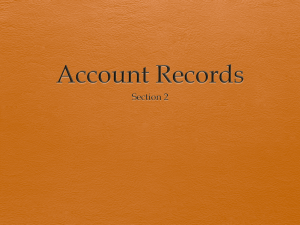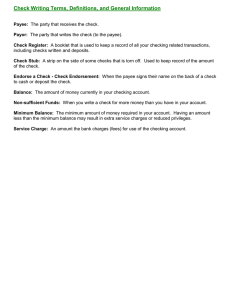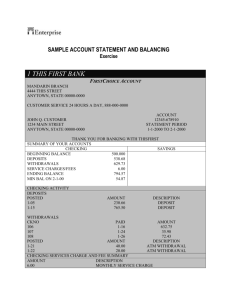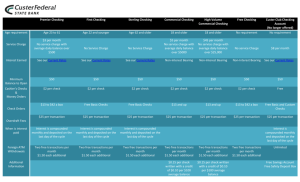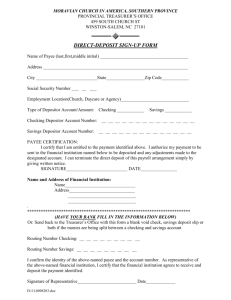banking terms
advertisement
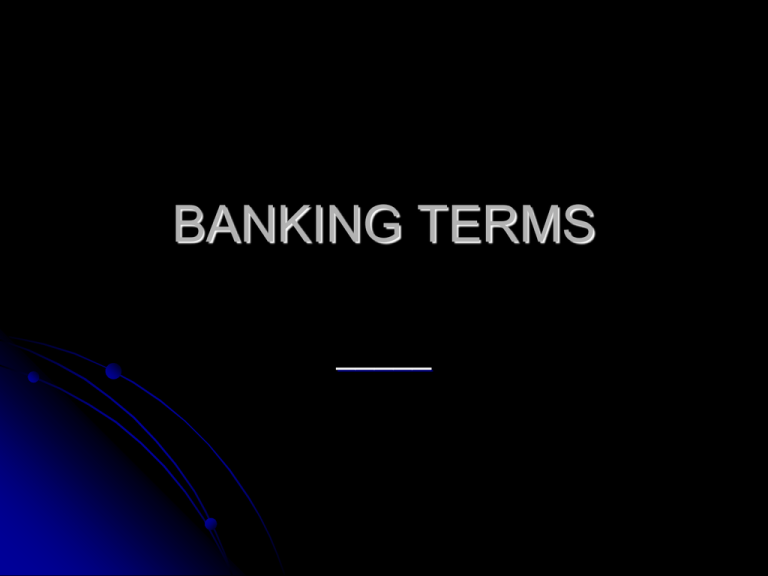
BANKING TERMS _____ _____ – Money deposited with a financial institution for investment and/or safekeeping purposes. – Items of monetary value (e.g., house, land, car), owned by an individual or a company _____ – Acronym for automated teller machine. _____ –In banking, balance refers to the amount of money in a particular account. _____ – A check that a bank has refused to cash or pay because you have no funds to cover it in your account. _____ _____ – A “used” check that has been paid and subtracted from the checkwriter’s account. Canceled checks have extra data on them from the bank. They are usually mailed to the writer each month with the statement, although many banks keep records that are available upon request. Canceled checks are excellent receipts that should be kept for reference and tax purposes. – A check issued by a bank, drawn on its own funds rather than on one of its depositors. _____ – Any written document instructing a bank to pay money from the writer’s account. _____ _____ – A banking card enhanced with ATM (automated teller machine) and pointof-sale (POS) features that can be used to purchase goods and services electronically. The card replaces cash and checks. Transactions are deducted from the cardholder’s checking account either immediately or within one to three days. Depending upon the type of card, a check card may require a signature or entering a PIN number into special equipment. – An account for which the holder can write checks. Checking accounts pay less interest than savings accounts, or none at all. _____ – A check “clears” when its amount is debited (subtracted) from the payer’s account and credited (added) to the payee’s account. _____ – Anything that a bank accepts as security against the debtor’s not repaying a loan. If the debtor fails to repay the loan, the bank is allowed to keep the collateral. Collateral is most commonly in the form of real estate (e.g., a home). _____ – In business, buying or borrowing on the promise to repay at a later date. In any credit arrangement there is a creditor (a person, bank, store, or company to whom money is owed) and a debtor (the person who owes money). _____ – An agency that checks credit information and keeps a complete file on people who apply for and use credit. _____ – A plastic card that gives access to a line of credit. Users are limited in how much they can charge, but they are not required to repay the full amount each month. Instead the balance (or “revolve”) accrues interest with only a minimum payment due. _____ _____– See Check Card. _____– An itemized slip showing the exact amount of paper money, coin, and checks being deposited to a particular account. _____ – An individual or company that puts money in a bank account. _____ – To write the payee’s own signature on the back of a check before cashing, depositing, or giving it to someone else. The first endorsement must be made by the payee to authorize the transaction. Later endorsements may be made by whoever receives the check. _____ – The fee paid for the use of money. Interest may be paid, for example, by an individual to a bank for credit card use, or by a bank to an individual for holding a savings account; interest is expressed in terms of annual percentage rate (APR). _____– A savings or checking account established in the names of more than one person (e.g., parent/child, wife/husband). _____ – Money owed to individuals, businesses, or institutions. _____ – a check written for more money than is currently in the account. If the bank refuses to cash the check, it is said to have ”bounced”. _____ – An individual or company to whom a check is written; one who receives money as payment. – An individual or company who writes a check; one who gives money as payment. _____ _____– _____– The original amount of money borrowed, deposited, or invested before interest accrues. A bank account that accrues interest in exchange for use of the money on deposit. _____– A monthly fee a bank charges for handling a checking account. _____– A request made to a bank to not pay a specific check. If requested soon enough, the check will not be debited from the payer’s account. Normally there is a charge for this service. _____ – An amount of money taken out of an account.
